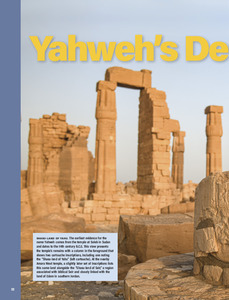Por favor, use este identificador para citar o enlazar este ítem:
https://repositorio.uca.edu.ar/handle/123456789/15051| Campo DC | Valor | Lengua/Idioma |
|---|---|---|
| dc.contributor.author | Tebes, Juan Manuel | es |
| dc.date.accessioned | 2022-09-22T12:30:45Z | - |
| dc.date.available | 2022-09-22T12:30:45Z | - |
| dc.date.issued | 2022 | - |
| dc.identifier.citation | Tebes, J. M. Yahweh's Desert Origins [en línea]. Biblical Archaeology Review. 2022. Disponible en: https://repositorio.uca.edu.ar/handle/123456789/15051 | es |
| dc.identifier.issn | 0098-9444 | - |
| dc.identifier.uri | https://repositorio.uca.edu.ar/handle/123456789/15051 | - |
| dc.identifier.uri | https://www.baslibrary.org/biblical-archaeology-review/48/3/2 | - |
| dc.description.abstract | We all know that Yahweh was, first and foremost, ancient Israel’s God. Yet, even after hundreds of years of archaeology and biblical scholarship, we know very little about his origins—and how he came to be worshiped by the peoples of Israel and Judah. Scholars have searched for the name Yahweh in ancient West Semitic texts, especially those found at Ebla, Mari, and Ugarit, but no evidence of pre-Israelite Yahweh worship among the peoples of the ancient Levant has surfaced. If Yahweh wasn’t originally a Levantine deity, where did he come from, and when exactly did he become the national God of Israel? Many scholars, including myself, have used the available biblical and archaeological evidence to argue that Yahweh originated in the desert lands south of ancient Judah. Although most look to details from the story of Moses in Midian (Exodus 2–4) to argue that Yahweh became Israel’s God during the time of the Exodus (the so-called Midianite Hypothesis), I believe that the Israelites only encountered this desert deity centuries later, during the tenth century B.C.E., when the kingdoms of Israel and Judah were in frequent contact with the pastoral-nomadic peoples of the southern deserts. Before discussing the archaeological evidence for Yahweh’s emergence, let us fi rst review the Midianite Hypothesis and biblical texts related to Yahweh’s southern origins... | es |
| dc.format | application/pdf | es |
| dc.language.iso | eng | es |
| dc.publisher | Biblical Archaeology Society | es |
| dc.rights | Acceso abierto | * |
| dc.rights.uri | http://creativecommons.org/licenses/by-nc-sa/4.0/ | * |
| dc.source | Biblical Archaeology Review. 2022 | es |
| dc.subject | BIBLIA | es |
| dc.subject | YAHVE | es |
| dc.subject | HISTORIA ANTIGUA | es |
| dc.subject | INTERPRETACION BIBLICA | es |
| dc.subject | MANUSCRITOS BIBLICOS | es |
| dc.subject | NOMBRES DE DIOS | es |
| dc.title | Yahweh's Desert Origins | es |
| dc.type | Artículo | es |
| uca.disciplina | HISTORIA | es |
| uca.issnrd | 1 | es |
| uca.affiliation | Fil: Tebes, Juan Manuel. Pontificia Universidad Católica Argentina. Facultad de Ciencias Sociales. Departamento de Historia. Centro de Estudios de Historia del Antiguo Oriente; Argentina | es |
| uca.affiliation | Fil: Tebes, Juan Manuel. Consejo Nacional de Investigaciones Científicas y Técnicas; Argentina | es |
| uca.version | publishedVersion | es |
| item.languageiso639-1 | en | - |
| item.grantfulltext | open | - |
| item.fulltext | With Fulltext | - |
| crisitem.author.dept | Facultad de Ciencias Sociales | - |
| crisitem.author.dept | Instituto de Investigaciones de la Facultad de Ciencias Sociales (IICS) | - |
| crisitem.author.dept | Consejo Nacional de Investigaciones Científicas y Técnicas | - |
| crisitem.author.dept | Centro de Estudios de Historia del Antiguo Oriente (CEHAO) | - |
| crisitem.author.dept | Programa de Estudios de las Sociedades Premodernas (PESPREM) | - |
| crisitem.author.orcid | 0000-0002-9623-3380 | - |
| crisitem.author.parentorg | Pontificia Universidad Católica Argentina | - |
| crisitem.author.parentorg | Facultad de Ciencias Sociales | - |
| crisitem.author.parentorg | Departamento de Historia | - |
| crisitem.author.parentorg | Instituto de Investigaciones de la Facultad de Ciencias Sociales (IICS) | - |
| Aparece en las colecciones: | Artículos | |
Ficheros en este ítem:
| Fichero | Descripción | Tamaño | Formato | |
|---|---|---|---|---|
| yahwehs-desert-origins.pdf | 20,68 MB | Adobe PDF |  Visualizar/Abrir |
Visualizaciones de página(s)
771
comprobado en 27-abr-2024
Descarga(s)
12.402
comprobado en 27-abr-2024
Google ScholarTM
Ver en Google Scholar
Este ítem está sujeto a una Licencia Creative Commons

